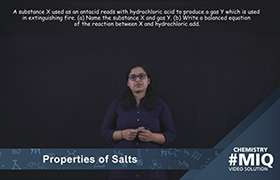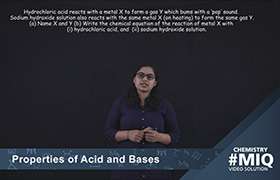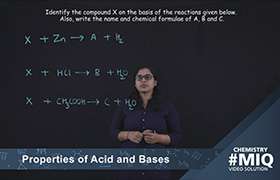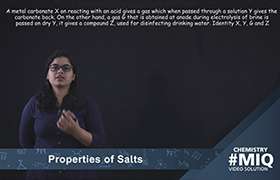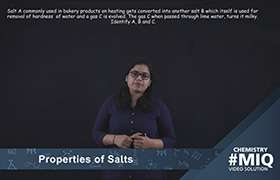CBSE Class 10 Answered
pH is the measure of the acidity or alkalinity of a solution. It is formally a measure of the activity of dissolved hydrogen ions (H+), but for very dilute solutions, the molarity (molar concentration) of H+ may be used as a substitute with little loss of accuracy.[1] In solution, hydrogen ions occur as a number of cations including hydronium ions (H3O+). In pure water at 25 °C, the concentration of H+ equals the concentration of hydroxide ions (OH-). This is defined as "neutral" and corresponds to a pH level of 7.0. Solutions in which the concentration of H+ exceeds that of OH- have a pH value lower than 7.0 and are known as acids. Solutions in which OH- exceeds H+ have a pH value greater than 7.0 known as bases. Because pH is dependent on ionic activity, a property which cannot be measured easily or fully predicted theoretically, it is difficult to determine an accurate value for the pH of a solution. The pH reading of a solution is usually obtained by comparing unknown solutions to those of known pH, and there are several ways to do so.
pH is a dimensionless quantity
pH has no fundamental meaning as a unit; its official definition is a practical one. However in the restricted range of dilute aqueous solutions having an amount-of-dissolved-substance concentrations less than 0.1 mol/L, and being neither strongly alkaline nor strongly acidic (2 < pH < 12), the definition is such that
 the number arises from a measure of the activity of hydrogen ions or their equivalent in the solution. The pH scale is an inverse logarithmic representation of hydrogen proton (H+) concentration. Unlike linear scales, which have a constant relationship between the item being measured (H+ concentration in this case) and the value reported, each individual pH unit is a factor of 10 different than the next higher or lower unit. For example, a change in pH from 2 to 3 represents a 10-fold decrease in H+ concentration, and a shift from 2 to 4 represents a one-hundred (10 × 10)-fold decrease in H+ concentration. The formula for calculating pH is:
the number arises from a measure of the activity of hydrogen ions or their equivalent in the solution. The pH scale is an inverse logarithmic representation of hydrogen proton (H+) concentration. Unlike linear scales, which have a constant relationship between the item being measured (H+ concentration in this case) and the value reported, each individual pH unit is a factor of 10 different than the next higher or lower unit. For example, a change in pH from 2 to 3 represents a 10-fold decrease in H+ concentration, and a shift from 2 to 4 represents a one-hundred (10 × 10)-fold decrease in H+ concentration. The formula for calculating pH is:Where αH+ denotes the activity of H+ ions, and is dimensionless. In solutions containing other ions, activity and concentration will not generally be the same. Activity is a measure of the effective concentration of hydrogen ions, rather than the actual concentration; it includes the fact that other ions surrounding hydrogen ions will shield them and affect their ability to participate in chemical reactions. These other ions change the effective amount of hydrogen ion concentration in any process that involves H+.
In dilute solutions such as tap water, activity is approximately equal to the numeric value of the concentration of the H+ ion, denoted as [H+] ([H3O+]), measured in moles per litre (also known as molarity). Therefore, it is often convenient to define pH as:
For both definitions, log10 denotes the base-10 logarithm, therefore pH defines a logarithmic scale of acidity. For example, if one makes a lemonade with a H+ concentration of 0.0050 moles per litre, its pH would be:
A solution of pH = 8.2 will have an [H+] concentration of 10−8.2 mol/L, or about 6.31 × 10−9 mol/L. Thus, its hydrogen activity αH+ is around 6.31 × 10−9. A solution with an [H+] concentration of 4.5 × 10−4 mol/L will have a pH value of 3.35.
In solution at 25 °C, a pH of 7 indicates neutrality (i.e. the pH of pure water) because water naturally dissociates into H+ and OH− ions with equal concentrations of 1×10−7 mol/L. A lower pH value (for example pH 3) indicates increasing strength of acidity, and a higher pH value (for example pH 11) indicates increasing strength of basicity. Note, however, that pure water, when exposed to the atmosphere, will take in carbon dioxide, some of which reacts with water to form carbonic acid and H+, thereby lowering the pH to about 5.7.
Neutral pH at 25 °C is not exactly 7. pH is an experimental value, so it has an associated error. Since the dissociation constant of water is (1.011 ± 0.005) × 10−14, pH of water at 25 °C would be 6.998 ± 0.001. The value is consistent, however, with neutral pH being 7.00 to two significant figures, which is near enough for most people to assume that it is exactly 7. The pH of water gets smaller with higher temperatures. For example, at 50 °C, pH of water is 6.55 ± 0.01. This means that a diluted solution is neutral when its pH at 50 °C is around 6.55, and also that a pH of 7.00 is very slightly basic.
Most substances have a pH in the range 0 to 14, although extremely acidic or extremely basic substances may have pH less than 0 or greater than 14. An example is acid mine runoff, with a pH = –3.6. Note that this does not translate to a molar concentration of 3981 M; such high activity values are the result of the extremely high value of the activity coefficient while concentrations are within a "reasonable" range.[8] E.g. a 7.622 molal H2SO4 solution has a pH = -3.13, hydrogen activity αH+ around 1350 and activity coefficient γH+ = 165.4 when using the MacInnes convention for scaling Pitzer single ion activity coefficient.[8]
Arbitrarily, the pH is − log10([H + ]). Therefore,
- pH = − log10[H + ]
or, by substitution,
 .
.
The "pH" of any other substance may also be found (e.g. the potential of silver ions, or pAg+) by deriving a similar equation using the same process. These other equations for potentials will not be the same, however, as the number of moles of electrons transferred (n) will differ for the different reactions.




